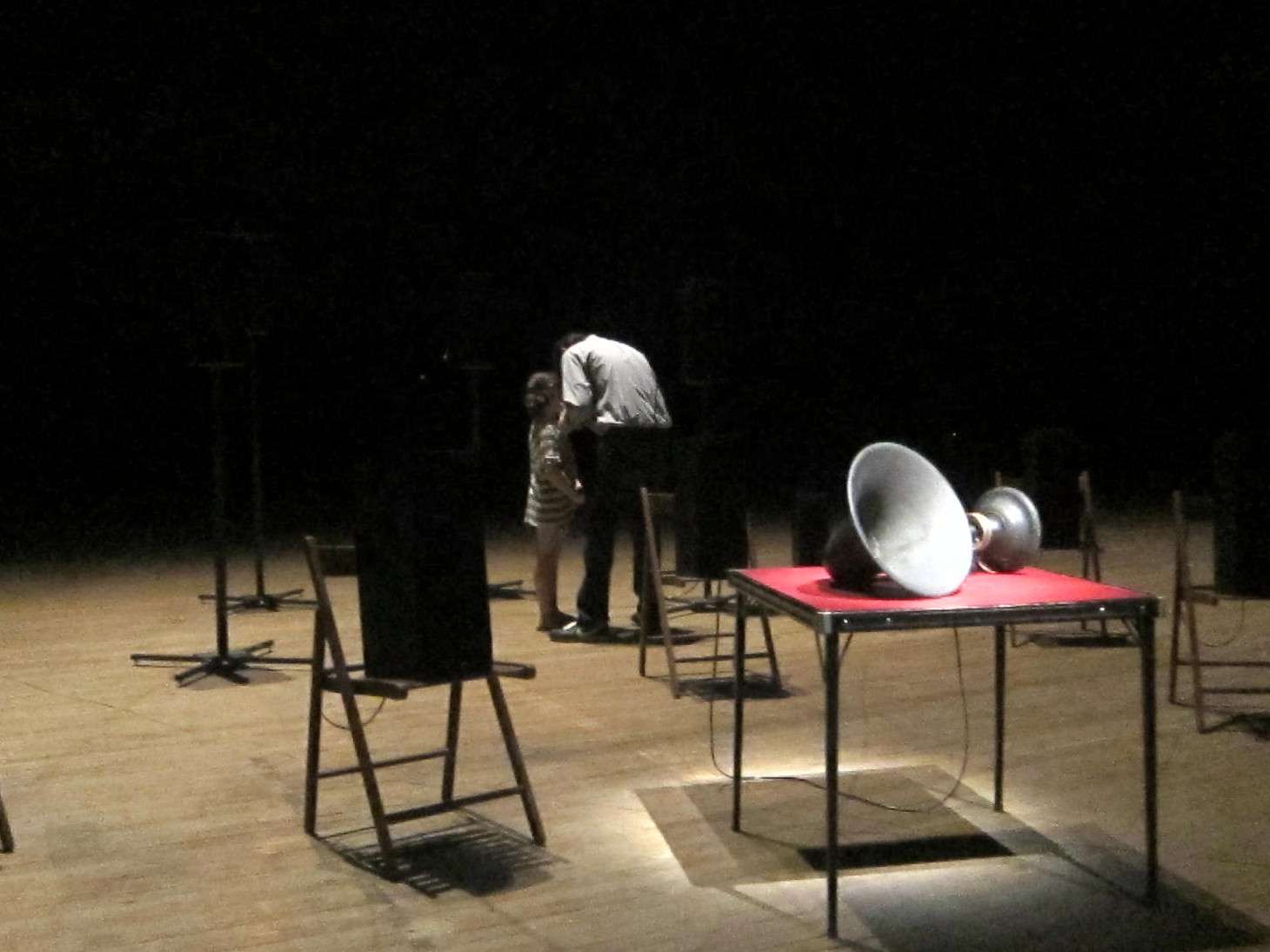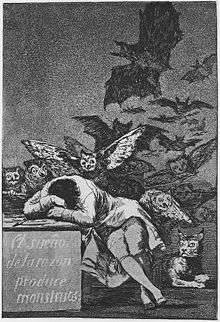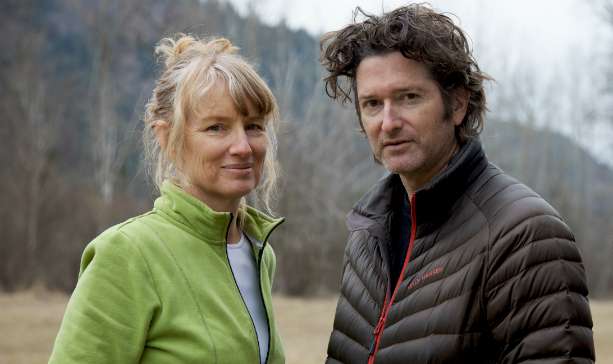|
Back
The “Caw-Caw-Caw” of the Wild New York
Wade Thompson Drill Hall, Park Avenue Armory
08/03/2012 - Through September 9, 2012
Freida Abtan: Lightness and Weight
Traditional Tibetan Prayer
Tilman Ritter, Orion Miller, James Cardiff, George Bures Miller: Bad Foot March
Vasily Lebedev-Kumach, Aleksandr Aleksandrov: The Sacred War
Tilman Ritter, James Cardiff, George Bures Miller: Murder of Crows Aria
Tilman Ritter: Dread
George Bures Miller: Crows Did Fly (Kathmandu Lullaby)
Nuns from Thrangu Tara Abbey, Kathmandu, Nepal, Viktor Skriptchenko, Tilman Ritter (Choir Conductors), Deutsches Film Orchester Babelsberg, Günter Joseck (Conductor)
Janet Cardiff, George Bures Miller (Concept, libretto, songs), Carlo Crovato (Installation Supervisor), Titus Madelechner (Recording, mixing and sound design)

Speaker (© Coco T. Dawg)
Walk through those mammoth doors into the darkened 55,000 square-foot large Wade Thompson Drill Hall any time between noon and 7pm, and you are bound to be initially disoriented. It is too big, confusing. The kleig lights from high up on the ceiling only make out a minuscule meerestone. A single table with one old-fashioned loudspeaker, in front of which are 55 slat seats.
So one makes tracks to find a seat, to become oriented, only to become completely confused by the sounds, which are–literally–coming from everywhere. For in this darkness around the table are almost 100 audio speakers, themselves black against the blackness, all of them pumping out (depending on when you arrive), the sounds of wind or a Soviet anti-capitalist anthem or the sounds of women in an orchestrated chant, like the female voices in the Bach Magnificat) or, yes, the sound of crows.
The Murder of Crows is billed as a “poetic and visceral sonic experience.” The creators, Vancouver-based Janet Cardiff and George Bures Miller, have produced many mammoth productions like this around the world. But they may be permitted here, with some justifiable hype. “This is a fluttering of voices, music, and sounds to construct a captivating and confounding melodrama that investigates concepts of love, loss and vulnerability.”
The success of this theater, which has neither human nor moving parts, is up to the viewer/listener. It may be measured by the children in the audience (who were scared of the sounds) or an older person (who strolled back and forth through the auditorium). But nobody can be bored.

Goya Inspiration (© Armory on Park)
The concept and title have various explanation. The picture above shows the nightmare etching by Francisco de Goya, from Los Caprichos, called “The Sleep of Reason Produces Monsters”. The title comes from the legendary legend that when a crow dies, hoards of its species encircle the body. Both images are unsettling. Yet neither explains the phantasmagorae of these 30 minutes.
The only physical interruptions to this pure sound comes from the aleatory movements of the audience. One child grew frightened at the sounds of crows, so she and her mother walked around the stage for consolation. Others, a little confused, walked to the back of the listening to the loudspeakers close up, or disappearing n their own shadows. A woman next to me was studiously following the libretto.
I sat through two shows. For the first, I was curious, took notes. Nothing separates each show, so for the second, I felt it most relaxing to close my eyes or pretend to be stoned, and then I walked around trying to get my bearings.
The music and sounds (more on that later), came from the 98 audio speakers and 21 amplifiers spread out over most of the auditorium. But the sound of the narrator cum dreamer, co-director Janet Cardiff, came from the one horn speaker set on the desk.
That desktop megaphone-shaped speaker takes on a life of its own, akin to the dictatorial sounds of 1984’s Big Brother or the movie Brazil. Like Finnegans Wake, we aren’t quite certain whether this is dream or reality, but the words are decidedly that of a terrifying evening
“...I was looking at the floor and there was red everywhere, and it was like there was blood everywhere...”
The images of blood, people moving slowly...a sandy beach...all smack of Baudelaire or Poe or Apollinaire or Rimbaud. But one doubts that they would mention cats and babies being thrown into a machine, “with blood spurting out.”
Still, nightmare is nightmare. Dreams are uncontrollable. Ground-up cats and babies and blood are “words, words, words, M’lord”, and words have no intrinsic meanings in themselves. So they were hardly grotesque.
The music and sounds, though, were intrinsically meaningful. The frightening sounds of crows brings to mind Bernard Hermann’s electronic sampling/amplification of crows in Hitchcock’s The Birds. But no movie theater had close to 100 loudspeakers, so the birds were far more fearsome. Other sounds included feet scampering, great waves and winds, water dripping, machines sawing (evidently slashing aforementioned pussies and babies), a dog barking.
That goes with this 2012 high-tech rendering of Grand Guignol. The music is, to say the least, eclectic. The Tibetan chant has been amplified and expanded into a momentous mantra. But the most memorable is a montage of orchestra and anthem.
The composers mentioned in the credits above have created a crescendo (against the factory noises) which are part Pärt (Arvo), part New Wave, with thumping strings and percussion against electronic background. This, though, segues into a remarkable artifact. Specifically, the 1941 Russian anthem of stinging rebukes against capitalism, a piece called “The Sacred War.”
Once again, this is a dream, so all is possible. As James Joyce used the Marx Brothers in Finnegans Wake, Soviet jingoism is certainly permitted here.

J. Cardiff, G.B. Miller (© Zev Tiefenbach)
The final song is not so stirring. The voice of Janet Cardiff with guitar in a 1970’s feel-good lullaby... ”Crows did fly/Through the Sky/I hear their cries/Sweet lullaby”, ending with “Close your eyes and try to sleep.”
A minute of silence and the work is repeated again...and again...about 14 times each day.
Personally, I loved it. I was not stirred, frightened, or transported into my own dreams. But this was pure theater, the theater of Artaud or Balinese gamelan. In all these production, one needn’t know the archaic or arcane languages, or even the meanings of dreams and legends. It is enough to experience a tsunami of creation, inspiration which can be pure or petrifying. But without a single person on stage, it is still an homage to the inhalation of breath, the exhalation of inspiration and the anarchic surrealism of dream and dreamer.
CODA: “The Murder of Crows” is performed every 30 minutes, from noon to 7 pm Tuesdays through Sundays. Thursdays, performances go on until 9 pm, through September 9. For more information, go to www.armoryonpark.org.
This is part of the Mostly Mozart Festival, where the International Contemporary Ensemble performs a program in the Armory on Sunday August 12 at 5pm featuring John Cage’s Telephones and Birds, the world premieres of Suzanne Farrin’s Serenade, Marcos Balter’s Passará, and Messiaen’s Chant dans le style Mozart
Harry Rolnick
|